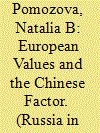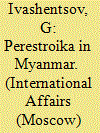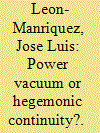|
|
|
Sort Order |
|
|
|
Items / Page
|
|
|
|
|
|
|
| Srl | Item |
| 1 |
ID:
172947


|
|
|
| 2 |
ID:
178806


|
|
|
|
|
| Summary/Abstract |
The paper discusses the prerequisites for the emergence of the Indo-
Pacific region, or Indo-Pacific, as a conceptual term to denote a new vast
geostrategic space that embraces closely connected countries facing similar
challenges. To this end, the article analyzes geopolitical transformations
that have brought about a change in the conceptualization of this macro-
region and India’s foreign policy strategy. The paper provides an overview of
neorealist and constructivist approaches characteristic of Moscow and New
Delhi, respectively. The paper argues that today Russia’s involvement in the
region is limited and by focusing on the Asia-Pacific Russia overlooks the vistas of closer relations with India. Russia could gain more if it changes its
perception of the Indo-Pacific as an American concept and takes a different,
constructivist approach. By ignoring new realities Russia deprives itself of
additional opportunities in Asia, which is especially important in view of its
general turn to the East and amid unceasing confrontation with the West.
|
|
|
|
|
|
|
|
|
|
|
|
|
|
|
|
| 3 |
ID:
148344


|
|
|
|
|
| Summary/Abstract |
Myanmar is an important country in both regional and international terms, being the biggest continental state in Southeast Asia (678,000 sq. km as compared to, say, 547,000 of France) with a population of 60 million, which has a rather high literacy rate (over 90%). The country is rich in natural resources,1 and it is located at the intersection of geopolitical routes connecting South Asia and Eastern Asia. In the first years of its independence, Burma/Myanmar played an active role in international affairs. It is a Buddhist country, and its foreign policy was based on some Buddhist principles which stipulated that the country should only rely on its own potential, steer a middle course, and avoid the extremes. Myanmar was pursuing the policy of equidistance from all world blocs, promoting the Five Principles of Peaceful Coexistence (the Pancha Shila), which has served to enhance its global stature. It is no coincidence that in 1961, U Thant, a representative of Burma, became the United Nations' third Secretary-General.
|
|
|
|
|
|
|
|
|
|
|
|
|
|
|
|
| 4 |
ID:
154418


|
|
|
|
|
| Summary/Abstract |
This article argues that the gradual decline of the United States’ economic presence in Latin America—and particularly in South America—reads as a manifestation of Washington’s hegemonic attrition in the world. Indeed, concerns over the Chinese incursion in Latin America and the increase of the pressures of the American hard line could transform the region into a scenario of geopolitical dispute between the two great powers. I first analyze the history of the relations between the United States and Latin America, which have followed a complex trajectory of interest, coercion, consensus, and carelessness. I then focus on bilateral relations since the 1990s and specify the political and economic transformations of Latin America in the first years of the twenty-first century and the consequent paralysis of the United States to understand these changes. The article then summarizes the contours of the dynamic commercial relations between Latin America and China, an emergent actor in the region. I conclude with an examination of the U.S. responses to Chinese presence in the Western hemisphere.
|
|
|
|
|
|
|
|
|
|
|
|
|
|
|
|
|
|
|
|
|